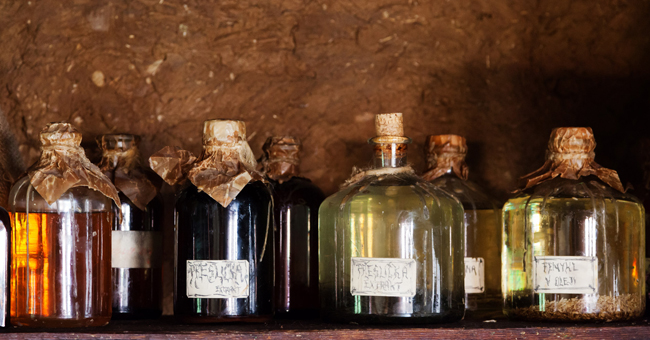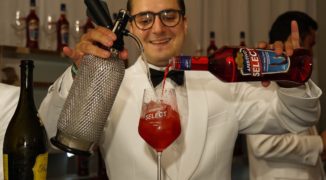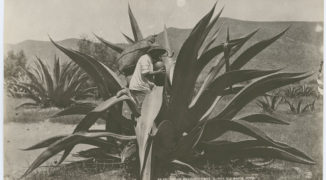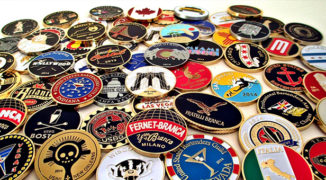It sounds too good to be true, but your favorite booze might just have healing properties. Or at least that’s what monks believed back when they first made their liqueurs in the 13th century. Originally developed as herbal medicines, these sweetened spirits flavored with a variety of ingredients like fruits, herbs and spices are key additions to many cocktails today. Yet hundreds of years ago, our ancestors sipped liqueurs to strengthen their constitution. “They thought multiple sips a day kept any ailments away,” says Vance Henderson, brand ambassador for Drambuie.
Europeans, including the ancient Greeks and Romans, have created botanical blends for medicinal purposes for thousands of years. “The monks were always trying to find a way to preserve botanicals,” says Marco Montefiori, Amaro Montenegro’s U.S. Market Manager. “So they started to put them in alcohol to keep them longer.” Sweetener, most often honey, was then added to these bitter concoctions to make them more palatable. “It’s a wonderful solution to concentrate things,” says Derek Brown, president of Drink Company in Washington, D.C. “That’s why people would use it — it’s much better than water. The alcohol can extract more.”
These medicinal liqueurs flourished in Europe’s monasteries, which were centers of knowledge about literature, medicine and of course winemaking and beer-brewing. “Monks were essentially more learned than the average population,” explains Brown. “The vast majority of humanity was illiterate, but you had monks who … could read the Bible. And what else did they have to do all day? Pray and make booze.”
Some liqueurs originally created by monks are still beloved today. The legends behind them are so fantastical, they seem ripped straight from the pages of a fairy tale. The most well-known example is Chartreuse, which was first made by Carthusian monks in France. According to legend, Henry IV, the king at that time in 1605, sent a representative to their monastery in Vauvert to deliver the directions for making the “elixir of long life.” The recipe for Chartreuse remains top secret to this day, but it’s said to require over 130 botanicals like cinnamon, mace, lemon balm, peppermint, thyme and angelica root. It’s still made in France using the same herbal mixture.
That image of robed monks, working in silence behind abbey walls to create magical concoctions, is an appealing one for many drinkers. “People like this kind of story,” says Brown. “It’s an interesting story that alcohol can somehow cure things for us.” A wealthy businessman named Alexandre Le Grand was well-aware of this fact and used it to sell Bénédictine for years. The recipe supposedly originated from a monastery that was destroyed during the French Revolution, but in reality, he had developed it himself during the 19th century.
No monks, real or imagined, were ever involved in the development of Drambuie, but the story behind that liqueur is equally fanciful. It’s said that after his defeat at the Battle of Culloden in Scotland in 1746, Prince Charles Edward Stuart (also known as Bonnie Prince Charlie) fled to the Isle of Skye. Captain John MacKinnon then came to his rescue. In a show of gratitude, the prince gifted him with the recipe for his family’s secret elixir. “People of status … had their own personal liqueurs and combinations of herbs and spices for these purposes,” says Henderson. Apparently the prince and his family swore by the elixir for increasing overall health and took a sip of it everyday or even multiple times a day. Like Chartreuse, the recipe remains under wraps, but it contains a mixture of heather honey, herbs, spices and Scotch.
Amari comprise a special group of liqueurs that Brad Thomas Parsons defines in his book “Amaro” as “the collective class of Italian-made aromatic, herbal and bittersweet liqueurs traditionally served as a digestif after a meal.” According to Montefiori of Amaro Montengero, the bitters stimulate the bile in the liver to promote digestion when consumed in small doses.
Amari’s traditional medicinal uses also stretch beyond improving digestion. Over the years, they’ve been been used to prevent malaria (quinine is made from cinchona bark, a common bittering agent in many amari), and also to reduce inflammation thanks to soothing herbs and spices like ginger, chamomile and clove.
During the 19th century, one Italian doctor even tried to develop an amaro as a cure for anemia. “He was cooking China barks on iron plates and blending them with either orange or any kind of citrus and adding egg yolks to make zabaione to feed to children or anybody that was anemic,” says Francesco Amodeo, president and master distiller of Don Ciccio & Figli. Today Amadeo’s company makes this particular amaro called Tonico Ferro-Kina.
In these days of modern medicine, it seems almost laughable that humans ever placed faith in that we now consider to be a simple cocktail ingredient. But some drinkers still swear by by amari as a hangover remedy (Amodeo vehemently disagrees. “That’s just a myth,” he says. “It just makes you drunker to continue the buzz.”). Perhaps we really have much more in common with our medieval counterparts than we’d like to believe.





